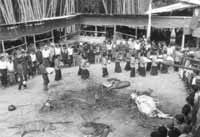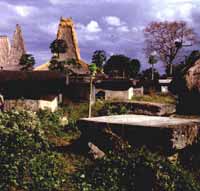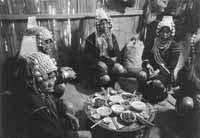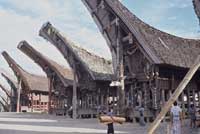 |
I chose Southeast Asia and Indonesia for this research because
this area is well-known for the importance of feasting in its
many traditional societies, and many accounts of feasts describe
them as being given entirely for prestige, or “merit,” either in
this world or the afterworld. Thus, it seemed to be a good test
case for the ecological model.
- The ethnoarcheological work that I am pursing in Indonesia
in conjunction with Ron Adams is focused on documenting:
- The range of feasts in traditional Torajan society,
- The costs and benefits of feasts, and
- The way that feasts are used to create political
alliances within and between communities.
Traditional Torajan communities range from transegalitarian to
simple chiefdom societies. Torajan funeral feasts are some of
the most extravagant competitive displays that we know of in
the contemporary world. More detailed analyses are presented
in a preliminary report by myself, and in Adams’ MA
Thesis. See also his in press article.
- Ron Adams has expanded this study to examine the role of
feasting in creating megalithic monuments in Sumba and the
benefits that megalithic construction confers upon those who
organize and pay for their construction. Results of recent
fieldwork are presented in a preliminary report by Adams (
 The
Megalithic Tradition of West Sumba – PDF
file). The analysis of Sumbanese
megalithic building will be compared to megalithic traditions
in the ethnographic literature of other societies in order to
determine whether there are global commonalities in megalithic
complexes and associated feasts. The
Megalithic Tradition of West Sumba – PDF
file). The analysis of Sumbanese
megalithic building will be compared to megalithic traditions
in the ethnographic literature of other societies in order to
determine whether there are global commonalities in megalithic
complexes and associated feasts.
- All this work follows on previous investigations among
transegalitarian Akha hill tribes in Thailand carried out by
myself in conjunction with Ralana Maneeprasert and Mike
Clarke. In this work, we documented the importance of feasting
in establishing lineage alliances (see reports by myself and
Maneeprasert, Clarke’s MA Thesis,his
published article, and his report (
 Hilltribe
Report –
PDF
file)). Mike Clarke also
documented a strong relationship between cooking vessel sizes
and feasting activities. Hilltribe
Report –
PDF
file)). Mike Clarke also
documented a strong relationship between cooking vessel sizes
and feasting activities.
Also available are additional reports by myself on exploratory
studies of feasting and political dynamics among hill tribes in
Laos and in Vietnam (with Professor Tran Quoc Vuong).
Publications and Theses:
- 2009 Hayden, Brian
- “Funerals as Feasts: Why Are They So Important?” Cambridge
Archaeological Journal 19:29–52.
- In press. Adams, Ron
- “An ethnoarchaeological study of feasting in Sulawesi,
Indonesia.” Journal of Anthropological Archaeology.
- 2003 Hayden, Brian
- “Were luxury foods the first domesticates?
Ethnoarchaeological perspectives from Southeast Asia.” World
Archaeology 34:458–469.
- 2001 Adams, Ron
- The ethnoarchaeology of Torajan feasting. Unpublished
MA Thesis, Simon Fraser University:
Burnaby, BC
- 2001 Clarke, Michael
- “Akha Feasting: An Ethnoarchaeological Perspective.” In Feasts:
Archaeological and ethnographic perspectives on food,
politics, and power, edited by M. Dietler and B. Hayden,
pp. 144–167. Washington, Smithsonian Institution Press.
- 2001 Hayden, Brian.
- “Fabulous feasts: A prolegomenon to the importance of
feasting.” In M. Dietler and B. Hayden (eds.), Feasts:
Archaeological and Ethnographic Perspectives on Food,
Politics, and Power. Smithsonian Institution Press:
Washington, DC. Pp. 23–64.
- 2001 Hayden, Brian
- “The Dynamics of Wealth and Poverty in the Transegalitarian
Societies of Southeast Asia.” Antiquity 75: 571–81.
- 1998 Clarke, Michael
- Feasting among the Akha of Northern Thailand. MA
Thesis, Archaeology Dept., Simon Fraser University, Burnaby,
British Columbia.
|

Torajan funeral feast

Sumban megaliths

Akha lineage women feasting
|
 |















 The
Megalithic Tradition of West Sumba –
The
Megalithic Tradition of West Sumba – 

